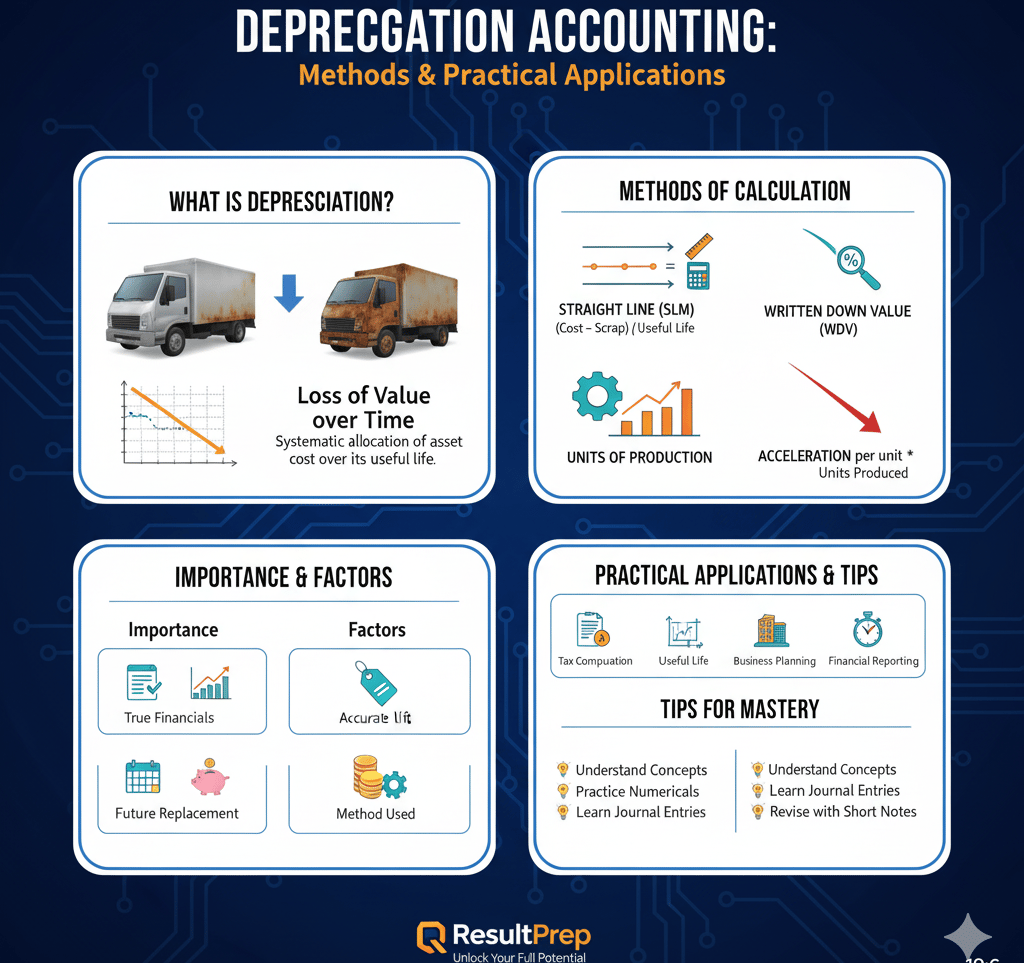💰 Depreciation Made Easy: Master Accounting Methods & Real-Life Applications
Confused about depreciation? 🤔 Learn how businesses calculate asset value loss using Straight Line, WDV, and other key methods! This blog simplifies Depreciation Accounting for CA Foundation, CUET Commerce, and Class 12 students — with clear examples, exam tips, and real-world insights to boost your accounting mastery. 📘📊
CA FOUNDATION
10/5/20253 min read


Accounting: Depreciation Accounting — Methods and Practical Applications
Depreciation is one of the most fundamental and essential topics in accounting. Whether you’re preparing for CA Foundation, CUET Commerce, or Class 12 Board Exams, understanding Depreciation Accounting is crucial. It helps students grasp how businesses allocate the cost of tangible assets over their useful life. This blog will simplify the concept of depreciation, explain its various methods, and discuss its real-world applications — helping students master this important accounting concept.
What Is Depreciation?
In simple terms, depreciation refers to the reduction in the value of a fixed asset over time due to usage, wear and tear, or obsolescence. Fixed assets like machinery, furniture, computers, and vehicles lose value as they are used in business operations.
In accounting, depreciation is treated as an expense, recorded in the Profit and Loss Account, and deducted from the asset’s value in the Balance Sheet to reflect its true current worth.
Definition (as per Accounting Standards):
Depreciation is a systematic allocation of the depreciable amount of an asset over its useful life.
Why Is Depreciation Important?
True and Fair Financial Position: It ensures assets are not overstated in the balance sheet.
Accurate Profit Calculation: By charging depreciation, we match the cost of assets against the revenue they help generate.
Provision for Replacement: Depreciation acts as a reserve for purchasing new assets in the future.
Compliance with Accounting Standards: Businesses must follow AS-10 (Property, Plant & Equipment) or Ind AS 16 for depreciation reporting.
Methods of Calculating Depreciation
Depreciation can be calculated using several methods depending on the nature and usage of the asset. Here are the most commonly used methods:
1. Straight Line Method (SLM)
Also known as the Fixed Installment Method, depreciation is charged uniformly every year over the useful life of the asset.
Example:
A machine costs ₹1,00,000, has a scrap value of ₹10,000, and a useful life of 5 years.
Merits: Simple and easy to calculate.
Demerits: Ignores the increasing repair cost as the asset gets older.
2. Written Down Value Method (WDV)
Under this method, depreciation is charged on the book value of the asset each year, leading to decreasing depreciation amounts annually.
Example:
If an asset costs ₹1,00,000 and the depreciation rate is 10% p.a.:
Year 1: ₹10,000
Year 2: ₹9,000
Year 3: ₹8,100, and so on.
Merits: Reflects actual usage pattern; realistic asset valuation.
Demerits: Complex compared to SLM and results in lower depreciation in later years.
3. Units of Production Method
Used mainly for machinery or equipment where depreciation depends on usage rather than time.
Example:
If a machine costs ₹5,00,000, has a residual value of ₹50,000, and produces 1,00,000 units in its life, depreciation per unit = ₹4.5.
If it produces 20,000 units in a year, depreciation = ₹90,000.
4. Sum of the Years’ Digits Method
In this method, depreciation is charged higher in the initial years and reduces later, similar to WDV but calculated differently.
For a 5-year asset, sum of digits = 1 + 2 + 3 + 4 + 5 = 15.
Depreciation is then distributed in the ratio 5:4:3:2:1 over 5 years.
5. Double Declining Balance Method
This is an accelerated depreciation method, charging double the rate of SLM on the book value each year.
It’s widely used in the U.S. and in industries where assets lose efficiency quickly.
Factors Affecting Depreciation
Cost of the Asset – Includes purchase price, taxes, installation, and transportation.
Useful Life – Duration the asset is expected to be operational.
Residual Value – Estimated value after its useful life.
Depreciation Method Used – Impacts annual expense and book value.
Practical Applications of Depreciation Accounting
Financial Reporting: Helps businesses present realistic financial statements by showing asset wear and tear.
Tax Computation: Depreciation is an allowable expense under the Income Tax Act, reducing taxable income.
Business Planning: Assists in budgeting for future asset replacement.
Loan and Valuation Purposes: Accurate asset valuation is critical for financial analysis and lending decisions.
Cost Accounting: Used in calculating the total cost of production for products and services.
Depreciation and Accounting Standards
In India, depreciation accounting follows Schedule II of the Companies Act, 2013, and AS-10 (Revised) or Ind AS 16, which provide guidelines for the calculation and disclosure of depreciation.
Tips to Master Depreciation for Exams
Understand Concepts First: Don’t memorize formulas blindly.
Practice Numerical Problems: Each method requires a different approach.
Learn Journal Entries: Know how to record depreciation in books of accounts.
Focus on Practical Scenarios: Apply concepts to real-life business examples.
Revise with Short Notes: Summarize each method with formulas and differences.
Conclusion
Depreciation is not just a theoretical accounting concept — it’s a real-world financial tool that helps companies value their assets accurately and manage profits responsibly. For students preparing for CA Foundation, CUET Commerce, or Class 12, mastering Depreciation Accounting builds a strong base for advanced topics like Asset Management and Financial Reporting.
At ResultPrep Coaching, we simplify complex accounting topics through visual examples, step-by-step calculations, and practical problem-solving sessions. Our structured study materials and mock tests help students gain conceptual clarity and exam confidence.
📞 Call: 8970007497
🌐 Visit: www.resultprep.com
Prepare for the best results!
Achieve your goals with expert coaching and support from ResultPrep.
Contact us:
© 2025. All rights reserved.
Address:
GSS Complex, 2nd Floor,
16th Cross Rd, HMT Layout, Vidyaranyapura, Bengaluru, Karnataka- 560097
